Recombinant Human ALPG Protein, Myc/DDK-tagged, C13 and N15-labeled
| Cat.No. : | ALPG-3335H |
| Product Overview : | ALPPL2 MS Standard C13 and N15-labeled recombinant protein (NP_112603) with a C-terminal MYC/DDK tag, was expressed in HEK293 cells. |
- Specification
- Gene Information
- Related Products
- Case Study
- Application
- Download
| Species : | Human |
| Source : | HEK293 |
| Tag : | DDK&Myc |
| Description : | There are at least four distinct but related alkaline phosphatases: intestinal, placental, placental-like, and liver/bone/kidney (tissue non-specific). The product of this gene is a membrane bound glycosylated enzyme, localized to testis, thymus and certain germ cell tumors, that is closely related to both the placental and intestinal forms of alkaline phosphatase. |
| Molecular Mass : | 55.2 kDa |
| AA Sequence : | MQGPWVLLLLGLRLQLSLGIIPVEEENPDFWNRQAAEALGAAKKLQPAQTAAKNLIIFLGDGMGVSTVTAARILKGQKKDKLGPETFLAMDRFPYVALSKTYSVDKHVPDSGATATAYLCGVKGNFQTIGLSAAARFNQCNTTRGNEVISVVNRAKKAGKSVGVVTTTRVQHASPAGTYAHTVNRNWYSDADVPASARQEGCQDIATQLISNMDIDVILGGGRKYMFPMGTPDPEYPDDYSQGGTRLDGKNLVQEWLAKHQGARYVWNRTELLQASLDPSVTHLMGLFEPGDMKYEIHRDSTLDPSLMEMTEAALRLLSRNPRGFFLFVEGGRIDHGHHESRAYRALTETIMFDDAIERAGQLTSEEDTLSLVTADHSHVFSFGGYPLRGSSIFGLAPGKARDRKAYTVLLYGNGPGYVLKDGARPDVTESESGSPEYRQQSAVPLDGETHAGEDVAVFARGPQAHLVHGVQEQTFIAHVMAFAACLEPYTACDLAPPAGTTDAAHPGPSVVPALLPLLAGTLLLLGTATAPTRTRPLEQKLISEEDLAANDILDYKDDDDKV |
| Purity : | > 80% as determined by SDS-PAGE and Coomassie blue staining |
| Stability : | Stable for 3 months from receipt of products under proper storage and handling conditions. |
| Storage : | Store at -80 centigrade. Avoid repeated freeze-thaw cycles. |
| Concentration : | 50 μg/mL as determined by BCA |
| Storage Buffer : | 100 mM glycine, 25 mM Tris-HCl, pH 7.3. |
| Gene Name | ALPG alkaline phosphatase, germ cell [ Homo sapiens (human) ] |
| Official Symbol | ALPG |
| Synonyms | ALPPL2; alkaline phosphatase, placental-like 2; alkaline phosphatase, placental-like; ALP-1; Nagao isozyme; germ cell alkaline phosphatase; alkaline phosphatase Nagao isozyme; placental-like alkaline phosphatase; testicular and thymus alkaline phosphatase; ALPG; GCAP; ALPPL; |
| Gene ID | 251 |
| mRNA Refseq | NM_031313 |
| Protein Refseq | NP_112603 |
| MIM | 171810 |
| UniProt ID | P10696 |
| ◆ Recombinant Proteins | ||
| ALPG-4646Y | Recombinant Human ALPG protein, His-Myc-tagged | +Inquiry |
| ALPG-325H | Recombinant Human ALPG Protein, His (Fc)-Avi-tagged | +Inquiry |
| ALPG-121HFL | Recombinant Full Length Human ALPG Protein, C-Flag-tagged | +Inquiry |
| ALPG-483H | Recombinant Human ALPG protein, hFc-tagged | +Inquiry |
| ALPG-0051H | Recombinant Human ALPG Protein (Ile20-Arg333), N-His-tagged | +Inquiry |
Case 1: Bi Y, et al. Cell Rep. 2020
Human naive pluripotent stem cells, derived from the epiblasts of early-stage blastocysts, offer vital insights into the regulation of pluripotency and cell differentiation. Significant progress has been achieved in refining culture conditions and pinpointing the molecular hallmarks of naive pluripotency. Yet, the specific surface markers unique to naive cells and the detailed molecular controls of their pluripotent state are not fully explored.
In this study, through comprehensive analyses of proteomic and transcriptomic data, researchers have identified alkaline phosphatase placental-like 2 (ALPPL2) as a key surface marker for naive stem cells. They also found that ALPPL2 plays a crucial role in both initiating and sustaining the naive pluripotent state. Additionally, the research reveals that ALPPL2 interacts with the RNA-binding protein IGF2BP1, which helps stabilize mRNA for the naive pluripotency transcription factors TFCP2L1 and STAT3, thereby influencing the regulation of naive pluripotency.
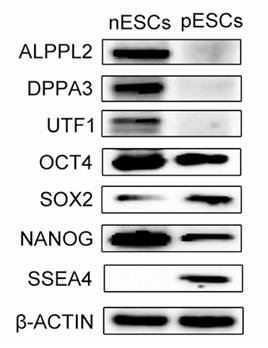
Fig1. Western blot analysis of pluripotency marker expression in nESCs and pESCs.
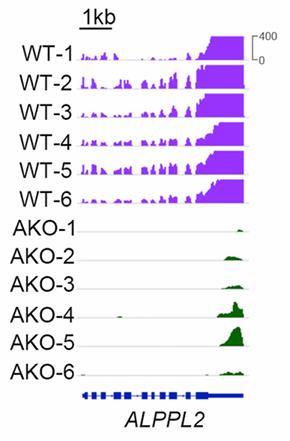
Fig2. RNA-seq signals at the ALPPL2 locus in nESCs before and after AKO as determined by Smart-Seq analysis.
Case 2: Dua P, et al. Cancer Res. 2013
Pancreatic ductal adenocarcinoma (PDAC) is an aggressive cancer with poor survival rates, often due to the absence of early diagnostic markers. To discover new biomarkers for early detection and treatment, researchers utilized a Cell-SELEX technique to develop RNA aptamers targeting PDAC. This approach identified an aptamer, SQ-2, with high specificity for pancreatic cancer cells. Employing target pull-down and microarray analysis, they pinpointed ALPPL-2, an oncofetal protein, as the target of SQ-2. ALPPL-2's ectopic expression in PDAC cell lines suggests a role in cancer cell growth and invasion. The aptamer's ability to detect ALPPL-2 on cancer cells and in secretions indicates its potential for diagnostic use in PDAC.
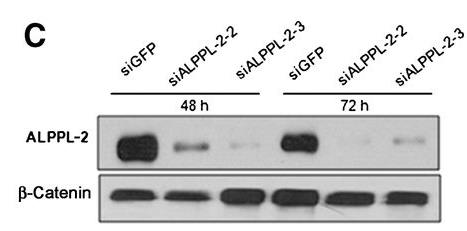
Fig1. WB analysis of Panc-1 positive cells transfected with siALPPL-2-2 and siALPPL-2-3.
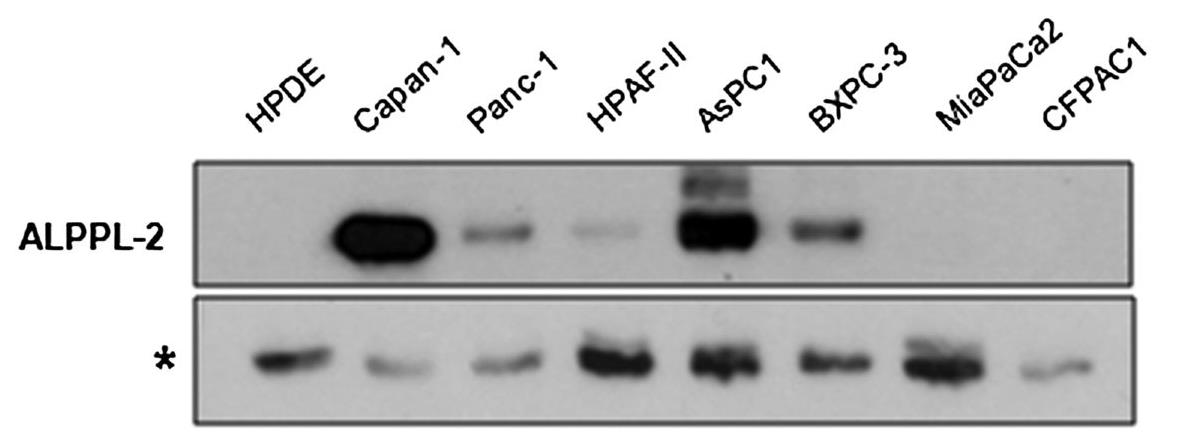
Fig2. ALPPL-2 Western blot analysis of membrane lysate of pancreatic cell lines.
ALPG Protein belongs to the alkaline phosphatase family, especially germ cell type alkaline phosphatase. This protein is mainly present in germ cells (such as sperm and eggs) and early embryonic stem cells, and is involved in the development and maturation process of germ cells, and has an important impact on the motor capacity and fertilization capacity of germ cells.
ALPG, as a highly specific cell surface antigen in a variety of cancers, can be an important target for CAR-T cell therapy. Especially in ovarian cancer, mesothelioma and other tumors, ALPG shows a high degree of specificity, enabling CAR T cell therapy to accurately attack tumor cells and reduce toxic effects on normal tissues. The efficacy of ALPG in the SynNotch CAR T system has been validated in ovarian cancer xenotransplantation models. This study demonstrates the potential of ALPG as a target and lays the foundation for further clinical applications.
Due to the specific expression of ALPG in germ cells, it can be used to study the development and maturation mechanisms of germ cells. Through in vitro experiments, researchers can explore the specific role of ALPG in these processes, thereby revealing the relevant physiological and pathological processes. The recombinant ALPG protein can be used to validate its potential as a drug target. Through in vitro drug screening experiments, researchers can look for small molecule compounds that can regulate the activity of ALPG, which may have the potential to treat related diseases.
ALPG is highly expressed in certain tumors, such as seminoma and ovarian cancer. This makes ALPG a potential tumor marker that could be used for early diagnosis and monitoring of these tumors. The expression level of ALPG is closely related to the malignant degree and prognosis of some tumors. For example, elevated ALPG levels in patients with liver cancer may indicate a poor prognosis. Therefore, detecting the expression or activity of ALPG can provide important prognostic information for the clinic.
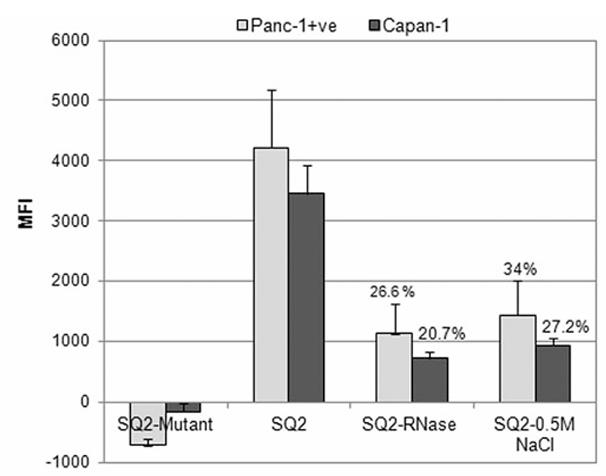
Fig1. NC-3000 analysis to calculate the amount of SQ2 internalization in pancreatic cancer cells. (Pooja Dua, 2015)
Not For Human Consumption!
Inquiry
- Reviews (0)
- Q&As (0)
Ask a Question for All ALPG Products
Required fields are marked with *
My Review for All ALPG Products
Required fields are marked with *



